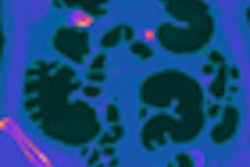
NEW YORK (Reuters Health), Apr 7 - Ultrasound can be useful in the workup of infants with a first urinary tract infection, researchers from Sweden report in the May issue of The Journal of Urology.
The most appropriate way to evaluate infants with a first urinary tract infection -- ultrasonography, or voiding cystourethrography, or renal scanning with dimercaptosuccinic acid (DMSA), or some combination of those -- has been controversial, according to senior author Dr. Sverker Hansson and colleagues from the University of Gothenburg.
To learn more about the role of ultrasound, the investigators obtained scans in 290 infants (161 males) with a first urinary tract infection. Along with ultrasonography, the babies underwent DMSA scintigraphy during the initial evaluation, followed within two months by cystourethrography.
One hundred twenty infants (41%) had 183 abnormal findings on ultrasound, including important structural abnormalities in 21 boys and 19 girls.
Ultrasound identified 17 of 27 children with dilating vesicoureteral reflux (grades III to V), but only five of 13 children with grade III reflux. Overall, ultrasound was 63% sensitive and 61% specific in identifying vesicoureteral reflux.
Abnormality on ultrasound was significantly associated with the presence and severity of abnormality on DMSA scan, with ultrasound showing 48% sensitivity and 66% specificity in detecting DMSA abnormalities.
The length of the longer kidney on ultrasound (expressed as the standard deviation) was directly related to the presence of inflammatory parameters such as body temperature and C-reactive protein level, and to the presence of DMSA scan abnormalities. For instance, among babies with the longest kidney length in the reference range, 22% had DMSA scan findings, compared to 67% of babies whose longest kidney was more than two standard deviations above the norm.
Outside the study, an additional 28 infants were diagnosed with dilatation on ultrasound prenatally (15 infants) and postnatally (13 infants).
Since it is nonvasive, ultrasonography is "an attractive alternative or complement to DMSA scan" for first-line imaging in infants with urinary tract infection, "especially in the absence of prenatal ultrasound during late pregnancy," the researchers conclude.
J Urol 2010;183:1984-1988
Last Updated: 2010-04-07 15:07:21 -0400 (Reuters Health)
Related Reading
Ultrasound alters management of infants with genitourinary disorders, October 14, 2004
Copyright © 2010 Reuters Limited. All rights reserved. Republication or redistribution of Reuters content, including by framing or similar means, is expressly prohibited without the prior written consent of Reuters. Reuters shall not be liable for any errors or delays in the content, or for any actions taken in reliance thereon. Reuters and the Reuters sphere logo are registered trademarks and trademarks of the Reuters group of companies around the world.


















